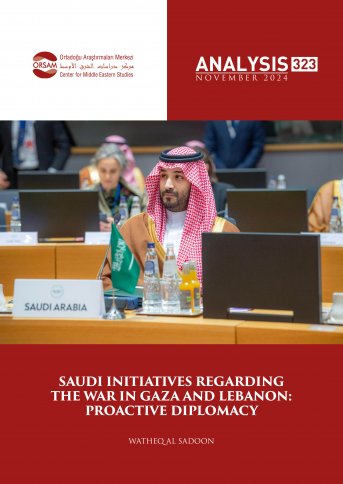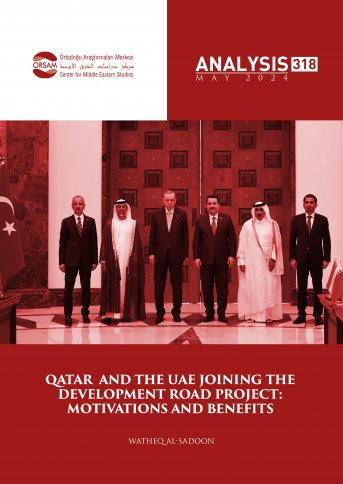
Iran-Backed Militia in Syria: Profiles and Functions
Since the onset of the crisis in Syria, Iran has sent many armed groups into the country, in addition to its own army units, with the aim of directly influencing the Assad regime’s military forces, which weakened after the popular uprising. Having played an active role in the process of reshaping the Shabiha organization, whose history dates back to the 1980s, under the name of the National Defense Forces (NDF), Iran could not achieve what it had desired from forming the NDF in terms of influencing the regime's defense policy. Iran’s experience in Iraq has resulted in the Hashd al-Shaabi organization, consisting of Iranian-backed militias, becoming a legal law enforcement agency after a long process and providing Iran with direct influence over the Iraqi forces.
Although the social structures of Syria and Iraq and their relations with regional actors are different, Damascus is at least as important as Baghdad in Iran's strategy to increase its influence in the region and reach the Mediterranean through Lebanon. For this reason, Tehran has chosen to increase its influence in Syria through different armed groups in addition to the NDF. The army unit under the command of Bashar Assad's brother, Maher Assad, the 4th Armored Division, is in close cooperation with the Iranian Revolutionary Guards and Hezbollah and stands as the most important extension of Tehran within the regime army. The 4th Armored Division, together with other Iranian-backed militias, strengthens the Iranian presence in the region with its policies targeting the former opposition elements under the auspices of Russia in southern Syria. The Assad regime plays a leading role in drug trafficking, which is the illegal source of finance, by undertaking tasks in the production and logistics of drugs, particularly Captagon.
Although the 4th Armored Division has autonomy within the regime army and is in close contact with Iran, it remains outside the scope of this study as it is an integral element of the Baath regime and a Baathist force. This study will deal with the Local Defense Forces (LDF), which are similar to the NDF elements in terms of their emergence and construction processes, and the Iranian-backed sectarian militias classified as "Shiite militias" in the literature and the functions of these forces in Iran's regional politics.
The LDF groups enabled Tehran to achieve its goal of having an official extension within the defense forces of the Assad regime, which was not possible through the NDF. The NDF remained distant from Iran’s goals for reasons such as the lack of an official assignment and Russia's increasing influence on some NDF elements. Alternatively, the LDF, which was established in 2013 and was organized in Aleppo, Deir ez-Zor, and Raqqa in the first stage, was accepted as an official element of the regime army with a decision taken by the Assad regime in 2017. It stands as a second example for Iran after the Hashd al-Shaabi. The LDF quickly grew to tens of thousands of people, relying entirely on Iran and Lebanese Hezbollah for everything, including weapons and ammunition support, military training, and salary payments, and became one of the most effective regime forces on the battlefield.
When the Afghan, Pakistani, Iraqi, Lebanese and local Shiite militia elements, whose numbers exceeded 40 thousand in the peak periods, are added to the LDF elements with a total of 50 thousand personnel, one could clearly see the extent of Iran’s power to shift the balance in the battlefield. Nevertheless Iran does not enjoy a total influence over all of these militia forces. The Jerusalem Brigade stands as an example that is in close contact with both Iran and Russia and adopts a position closer to one of these two actors according to the conjuncture. In addition to that there are also some groups that cooperate with the regime intelligence, the Ba’ath Brigades and the Republican Guards, apart from their close contact with Iran.
Iran has influenced the course of the civil war in favor of the regime by forming the NDF and LDF, and driving the Lebanese Hezbollah at first and then the foreign Shiite militias to the battlefield. Nevertheless, Iran’s intervention in the civil war resulted in the improbability of placing the regime army at the center of security policies and served as the driving force behind the “militia craze” that engulfed the regime bloc. Although Russia wanted to be the dominant force in Syria and opted for transforming the regime army into an active actor through the 5th Corps under its control, it became a militia sponsor actor when it could not overcome the “militia craze”. In fact, the intelligence elements of the Assad regime preferred to have a share in the militia craze instead of centralizing the regime army and making it a single great power, in order to exist in the battlefield despite the rising influence of Tehran and Moscow. To that end the regime honored the warlords, who have militia forces on their behalf, by placing them in the parliament in show elections, thereby revealing the importance of militias in Syria today.
Having supported the Shabiha group’s violent crackdown on the demonstrations in the first phase of the uprising, Tehran was looking for an opportunity to get organized in Syria through militias. However, Tehran launched this process after the regime army suffered great losses, including desertions, in the first year and a half of the war and failed to show the capacity to reverse the losses on the ground. Iran entered the battlefield through the local LDF and NDF militias and simultaneously activated the foreign militias that it brought. When the Lebanese Hezbollah entered the war alongside the failed regime army in Qusayr and turned the tide in favor of the regime, the balance started to shift in favor of the regime in Homs in the short term and in Damascus in the medium term. Having started sending Shiite militias to Syria after a holy war discourse focusing on the Tomb of Sayyidah Zainab, Tehran deployed many militias to many fronts in a short time. Having deployed militias in heavy numbers to the Shiite villages of Nubl and Zahra in addition to Qusayr, Iran benefited from these forces in the siege of the city during the years-long war in Aleppo, while harassing and threatening the Turkish and Syrian National Army (SNA) troops in northern Aleppo. In the south of Aleppo, the Afghan Fatimid Brigade, with its thousands of militias, played a great role on behalf of Iran during the siege of the city.
The Lebanese Hezbollah took an active role, especially in the eastern Ghouta region of the capital Damascus. It is widely known that the Iranian-backed Shiite militias played an important role in the chemical attack and inhuman siege practices in Ghouta in 2013 as much as the regime army. From this point of view, the Iranian-backed militias in Damascus and Aleppo, the two bloodiest fronts of the war, both played a role in changing the fate of the war and went down in history as the perpetrators of many war crimes that are the subject to the international law. The Iranian-backed militias came to the fore at a time when the regime army lost its functional structure and the regime was weakening after continuous territorial losses. These militias, which enabled the survival of the regime first and then bestowed upon it an advantageous position with the intervention of Russia, are the only tools Iran uses to "build influence" and "balance other actors" on the eastern Mediterranean route by 2022.
The militia forces, which are used as a counterbalance to Turkey in the north, the USA in the south and the east, and Russia in the areas under the control of the regime, also enable Tehran to prepare an ideological ground for itself in the region. In addition to all these, both the survival of the regime and the reduction of the operational costs of the militias in the country, which was economically devastated, led to the use of illegal financing methods. This means that Iranian-backed militias have vital roles in the Syria-based drug network that affects the entire region.




